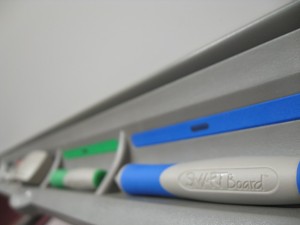Mooney SMART Board lab: Why 3 screens are better than 1
In the spring semester, Elon professors had an opportunity to experiment with a new teaching environment: multiple SMART Boards in one classroom. The project is an effort to prepare students in Elon’s teacher education program for the technology they will likely see in their classrooms when they are teachers. Multiple boards also means that students are encouraged to interact with them as well, rather than thinking of them as a tool solely for the teacher’s use.
The Plan
The need for the lab was initially brought up by Elon faculty. They requested a place to teach students in the teacher education program how to use SMART technology because it’s commonly used in K-12 classrooms. Alamance County classrooms often include interactive whiteboards, but many teachers haven’t seen effective use of the technology – a problem that this lab will help solve.
The Setup
The classroom has SMART boards and their corresponding projectors set up in the front, back, and on one side of the room, with an additional (non-interactive) screen in the front of the room, for a total of four projectors. Other than the SMART Boards, the classroom has a standard Elon setup, making it practical to use even for professors that aren’t interested in utilizing the new technology.
Since the boards can communicate between each other, one document could potentially be displayed on three screens, with six people writing on it simultaneously. The boards can also display different images, allowing (for example) three pages of a document to be presented at the same time. Up to 26 people can connect to the boards simultaneously, and each board can display 4 images simultaneously, allowing students to make their screens easily visible to each other. In addition, the new model of SMART Board purchased for the lab is dual-touch capable, meaning that two people can write on the screen at once.
MORE: Read more about the SMART Board lab on The Pendulum’s website.
In Practice
Jeff Carpenter, Assistant Professor of Education and director of the Teaching Fellows program, is one professor who has had hands-on experience teaching in the lab. He came up with several creative ways to integrate the boards into his lessons, primarily by using them as a collaborative workspace. He uses the boards for things as simple as putting a prompt on one board and writing responses on others. It’s also much more convenient for one student to display their screen to everyone in their classroom. One interesting suggestion by Professor Carpenter was that while presenting slides on the screens in the front of the classroom, a professor could be reading from the screen in the back, rather than constantly turning around to see the PowerPoint displayed behind them. In general, he says that the boards create a more interactive space which easily transitions between different modes (lecturing, classwork and group work).
Mooney 206 is open for anyone’s use when classes aren’t taking place (students are encouraged to come and experiment with the boards), and professors interested in teaching in the lab can speak to the registrar, though assignments are based on need.
Thanks to AV Systems Integrator Joseph Rich and Assistant Director of Campus Technology Joe Davis for their help with this article.
Image by Josh Allen | Creative Common Licensed CC BY-SA 2.0

 Follow
Follow